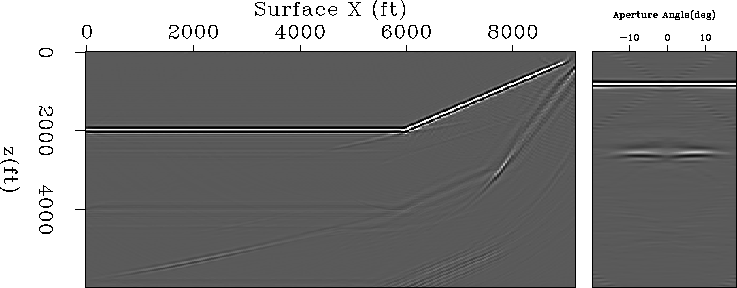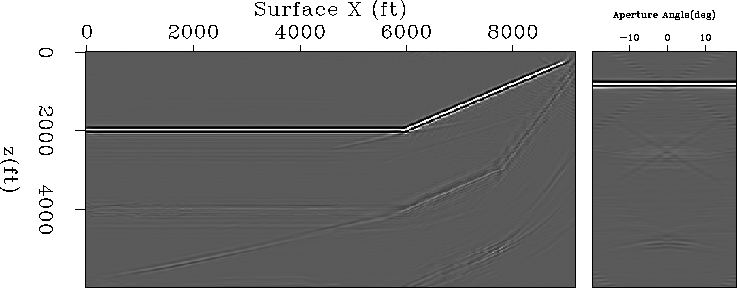




Next: SIGSBEE
Up: Synthetic Data
Previous: Use of ADCIGs
The advantage of working with image-space SRMP is that we have access to angle-domain information, which can be used to infill the missing angles in the multiple model. When using the perfect migration velocity, angle gathers look flat and extrapolating farther angles is fairly straightforward. A simplistic approach like stacking along angles and then spraying the normalized energy to other angles (stack and spray) can work well in case of flat gathers.
I use the algorithm proposed by Alvarez and Guitton (2006) (matching filters and adaptive subtraction) as a tool for removing multiples. If the image space subtraction is carried out on an ADCIG by ADCIG basis, the algorithm tries to account for the differences in amplitudes as well as the illumination range of modeled and recorded multiples. Adaptive matching works well for the ADCIGs corresponding to this example. When we do multiple removal in the data domain, we also use adaptive subtraction, but it is easier to match the missing parts in the angle domain, since the patterns are much simpler. If the velocity is perfect, events in the angle domain are flat. Secondly, in the angle domain we can enhance the performance of adaptive subtraction using the stack-and-spray approach or the Radon transforms in the case of complex situations, which is difficult to do when we are dealing with subtraction in the data domain.
In Figure ![[*]](http://sepwww.stanford.edu/latex2html/cross_ref_motif.gif) , I compare angle gathers for the original multiple model, the reconstructed multiple model generated using a stack-and-spray approach, and the one reconstructed using the adaptive-matching algorithm. Once we reconstruct the missing angles, we can carry out the process of subtraction.
, I compare angle gathers for the original multiple model, the reconstructed multiple model generated using a stack-and-spray approach, and the one reconstructed using the adaptive-matching algorithm. Once we reconstruct the missing angles, we can carry out the process of subtraction.
recon
Figure 9 ADCIG for (a) multiple model and reconstructed multiple model using (b) stack and spray and (c) adaptive approach





Finally, let us compare the image and the ADCIGs created by doing multiple removal in the data space to the one created in the image space using adaptive subtraction, working on one ADCIG at a time. Figure ![[*]](http://sepwww.stanford.edu/latex2html/cross_ref_motif.gif) is the result of multiple removal in the data space followed by migration, and Figure
is the result of multiple removal in the data space followed by migration, and Figure ![[*]](http://sepwww.stanford.edu/latex2html/cross_ref_motif.gif) is the result of multiple modeling in the image space followed by adaptive subtraction. The ADCIGs on right show the remains of the multiple energy in the former case at high angles, but nearly all the energy is gone in the latter.
is the result of multiple modeling in the image space followed by adaptive subtraction. The ADCIGs on right show the remains of the multiple energy in the former case at high angles, but nearly all the energy is gone in the latter.
imgbf
Figure 10 Image and a representative ADCIG at a surface location of 8000, created by data space multiple removal followed by migration




 imgaf
imgaf
Figure 11 Image and a representative ADCIG at a surface location of 8000, created by image space multiple removal










Next: SIGSBEE
Up: Synthetic Data
Previous: Use of ADCIGs
Stanford Exploration Project
5/6/2007
![[*]](http://sepwww.stanford.edu/latex2html/cross_ref_motif.gif) , I compare angle gathers for the original multiple model, the reconstructed multiple model generated using a stack-and-spray approach, and the one reconstructed using the adaptive-matching algorithm. Once we reconstruct the missing angles, we can carry out the process of subtraction.
, I compare angle gathers for the original multiple model, the reconstructed multiple model generated using a stack-and-spray approach, and the one reconstructed using the adaptive-matching algorithm. Once we reconstruct the missing angles, we can carry out the process of subtraction.


